IBM's Case Study: Analyzing Position, Joint Venture Roles and Challenges, and Ansoff Matrix Application
VerifiedAdded on 2023/06/13
|16
|4418
|274
AI Summary
This case study analyzes IBM's current position in the marketplace using Porter's Five Forces and Pestle models. It also discusses the roles and challenges of joint ventures as a mechanism for growth and applies Ansoff Matrix for new market entry. The study includes recommendations for IBM to improve its competitive edge and management strategies.
Contribute Materials
Your contribution can guide someone’s learning journey. Share your
documents today.
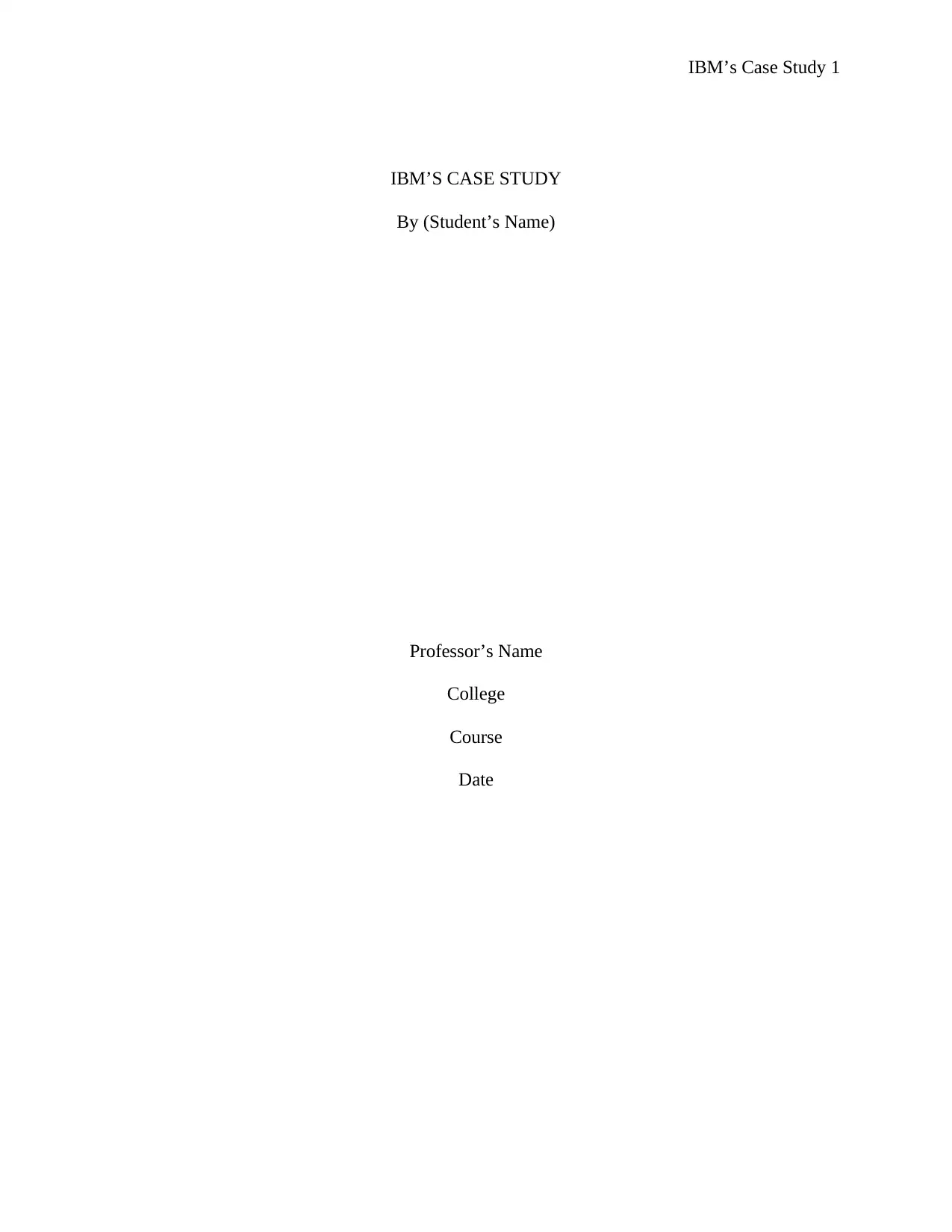
IBM’s Case Study 1
IBM’S CASE STUDY
By (Student’s Name)
Professor’s Name
College
Course
Date
IBM’S CASE STUDY
By (Student’s Name)
Professor’s Name
College
Course
Date
Secure Best Marks with AI Grader
Need help grading? Try our AI Grader for instant feedback on your assignments.
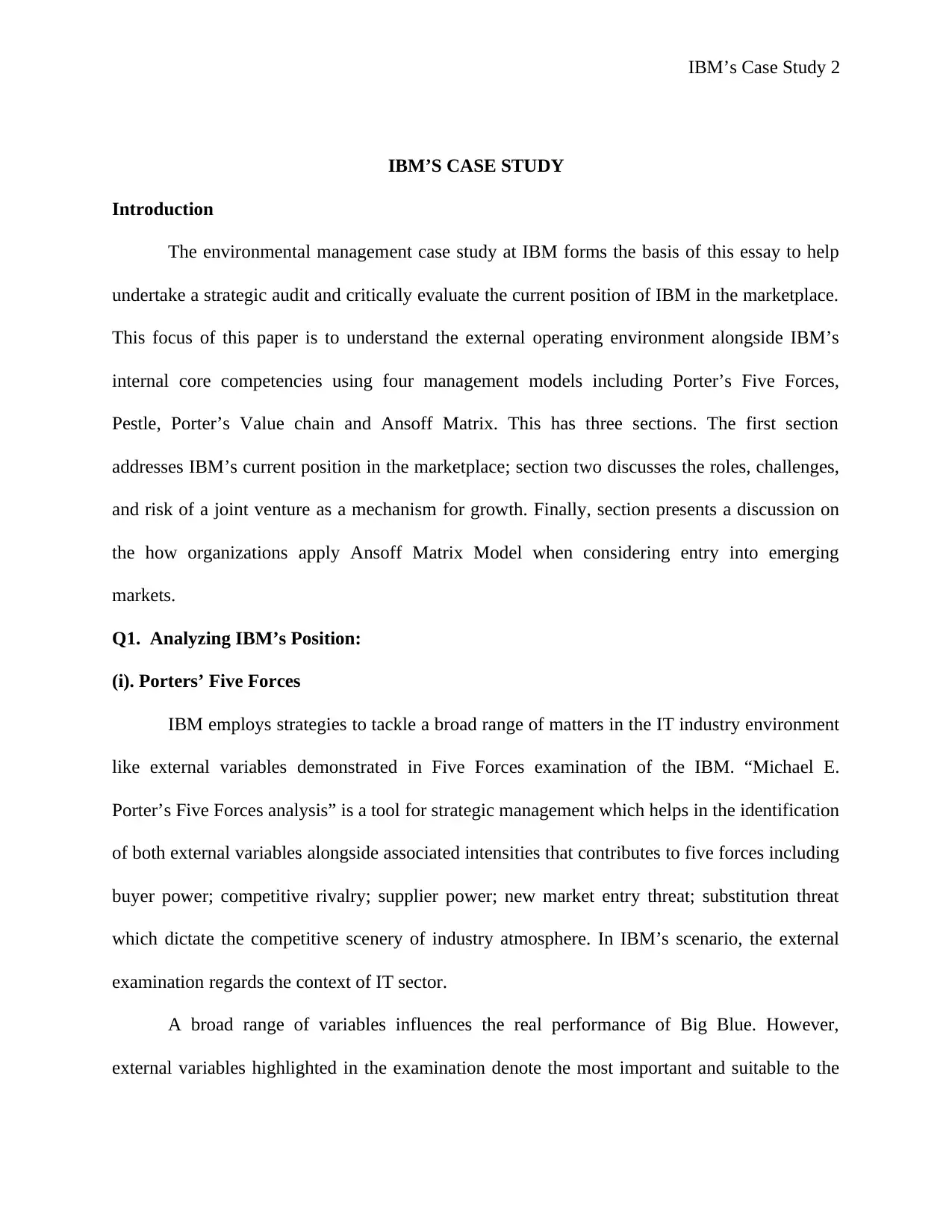
IBM’s Case Study 2
IBM’S CASE STUDY
Introduction
The environmental management case study at IBM forms the basis of this essay to help
undertake a strategic audit and critically evaluate the current position of IBM in the marketplace.
This focus of this paper is to understand the external operating environment alongside IBM’s
internal core competencies using four management models including Porter’s Five Forces,
Pestle, Porter’s Value chain and Ansoff Matrix. This has three sections. The first section
addresses IBM’s current position in the marketplace; section two discusses the roles, challenges,
and risk of a joint venture as a mechanism for growth. Finally, section presents a discussion on
the how organizations apply Ansoff Matrix Model when considering entry into emerging
markets.
Q1. Analyzing IBM’s Position:
(i). Porters’ Five Forces
IBM employs strategies to tackle a broad range of matters in the IT industry environment
like external variables demonstrated in Five Forces examination of the IBM. “Michael E.
Porter’s Five Forces analysis” is a tool for strategic management which helps in the identification
of both external variables alongside associated intensities that contributes to five forces including
buyer power; competitive rivalry; supplier power; new market entry threat; substitution threat
which dictate the competitive scenery of industry atmosphere. In IBM’s scenario, the external
examination regards the context of IT sector.
A broad range of variables influences the real performance of Big Blue. However,
external variables highlighted in the examination denote the most important and suitable to the
IBM’S CASE STUDY
Introduction
The environmental management case study at IBM forms the basis of this essay to help
undertake a strategic audit and critically evaluate the current position of IBM in the marketplace.
This focus of this paper is to understand the external operating environment alongside IBM’s
internal core competencies using four management models including Porter’s Five Forces,
Pestle, Porter’s Value chain and Ansoff Matrix. This has three sections. The first section
addresses IBM’s current position in the marketplace; section two discusses the roles, challenges,
and risk of a joint venture as a mechanism for growth. Finally, section presents a discussion on
the how organizations apply Ansoff Matrix Model when considering entry into emerging
markets.
Q1. Analyzing IBM’s Position:
(i). Porters’ Five Forces
IBM employs strategies to tackle a broad range of matters in the IT industry environment
like external variables demonstrated in Five Forces examination of the IBM. “Michael E.
Porter’s Five Forces analysis” is a tool for strategic management which helps in the identification
of both external variables alongside associated intensities that contributes to five forces including
buyer power; competitive rivalry; supplier power; new market entry threat; substitution threat
which dictate the competitive scenery of industry atmosphere. In IBM’s scenario, the external
examination regards the context of IT sector.
A broad range of variables influences the real performance of Big Blue. However,
external variables highlighted in the examination denote the most important and suitable to the
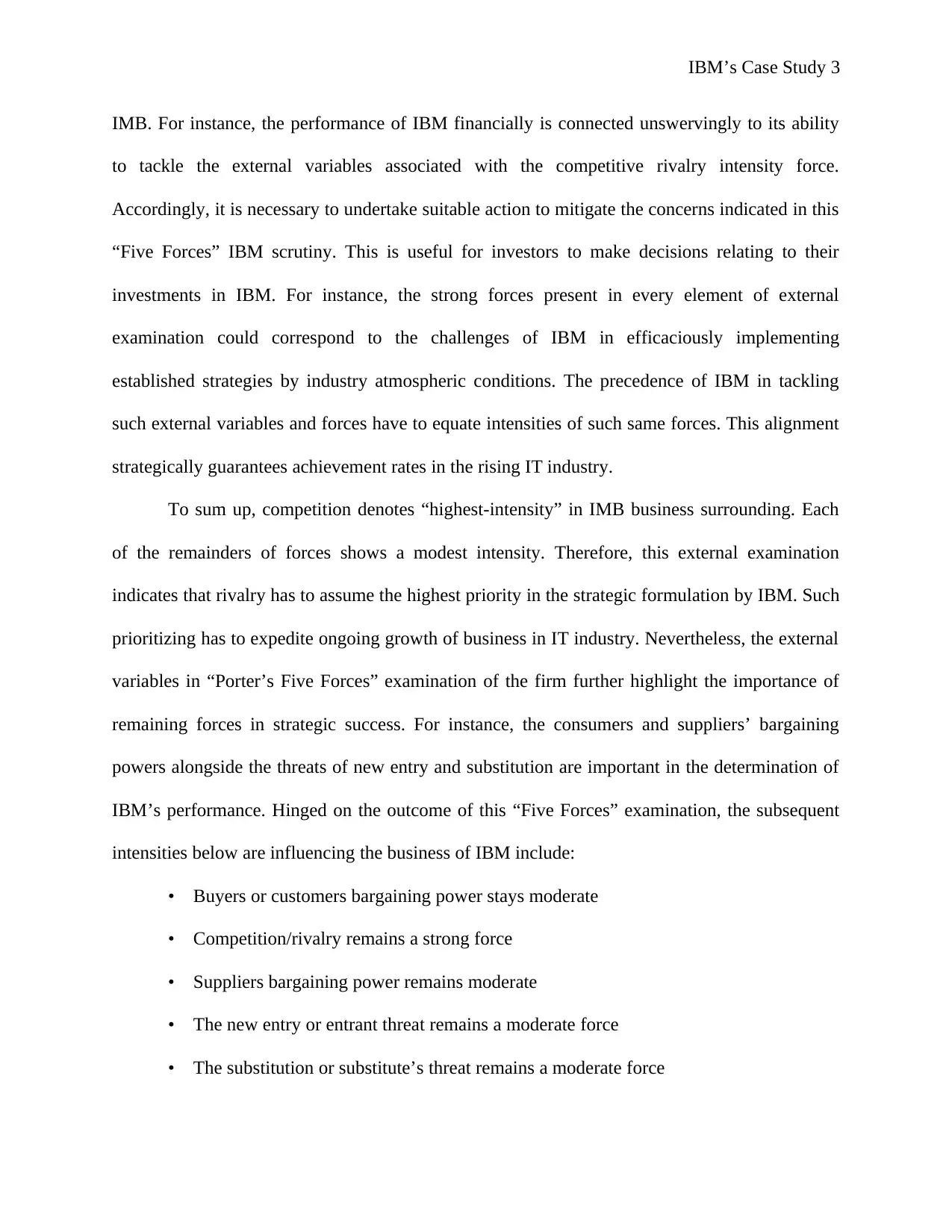
IBM’s Case Study 3
IMB. For instance, the performance of IBM financially is connected unswervingly to its ability
to tackle the external variables associated with the competitive rivalry intensity force.
Accordingly, it is necessary to undertake suitable action to mitigate the concerns indicated in this
“Five Forces” IBM scrutiny. This is useful for investors to make decisions relating to their
investments in IBM. For instance, the strong forces present in every element of external
examination could correspond to the challenges of IBM in efficaciously implementing
established strategies by industry atmospheric conditions. The precedence of IBM in tackling
such external variables and forces have to equate intensities of such same forces. This alignment
strategically guarantees achievement rates in the rising IT industry.
To sum up, competition denotes “highest-intensity” in IMB business surrounding. Each
of the remainders of forces shows a modest intensity. Therefore, this external examination
indicates that rivalry has to assume the highest priority in the strategic formulation by IBM. Such
prioritizing has to expedite ongoing growth of business in IT industry. Nevertheless, the external
variables in “Porter’s Five Forces” examination of the firm further highlight the importance of
remaining forces in strategic success. For instance, the consumers and suppliers’ bargaining
powers alongside the threats of new entry and substitution are important in the determination of
IBM’s performance. Hinged on the outcome of this “Five Forces” examination, the subsequent
intensities below are influencing the business of IBM include:
• Buyers or customers bargaining power stays moderate
• Competition/rivalry remains a strong force
• Suppliers bargaining power remains moderate
• The new entry or entrant threat remains a moderate force
• The substitution or substitute’s threat remains a moderate force
IMB. For instance, the performance of IBM financially is connected unswervingly to its ability
to tackle the external variables associated with the competitive rivalry intensity force.
Accordingly, it is necessary to undertake suitable action to mitigate the concerns indicated in this
“Five Forces” IBM scrutiny. This is useful for investors to make decisions relating to their
investments in IBM. For instance, the strong forces present in every element of external
examination could correspond to the challenges of IBM in efficaciously implementing
established strategies by industry atmospheric conditions. The precedence of IBM in tackling
such external variables and forces have to equate intensities of such same forces. This alignment
strategically guarantees achievement rates in the rising IT industry.
To sum up, competition denotes “highest-intensity” in IMB business surrounding. Each
of the remainders of forces shows a modest intensity. Therefore, this external examination
indicates that rivalry has to assume the highest priority in the strategic formulation by IBM. Such
prioritizing has to expedite ongoing growth of business in IT industry. Nevertheless, the external
variables in “Porter’s Five Forces” examination of the firm further highlight the importance of
remaining forces in strategic success. For instance, the consumers and suppliers’ bargaining
powers alongside the threats of new entry and substitution are important in the determination of
IBM’s performance. Hinged on the outcome of this “Five Forces” examination, the subsequent
intensities below are influencing the business of IBM include:
• Buyers or customers bargaining power stays moderate
• Competition/rivalry remains a strong force
• Suppliers bargaining power remains moderate
• The new entry or entrant threat remains a moderate force
• The substitution or substitute’s threat remains a moderate force
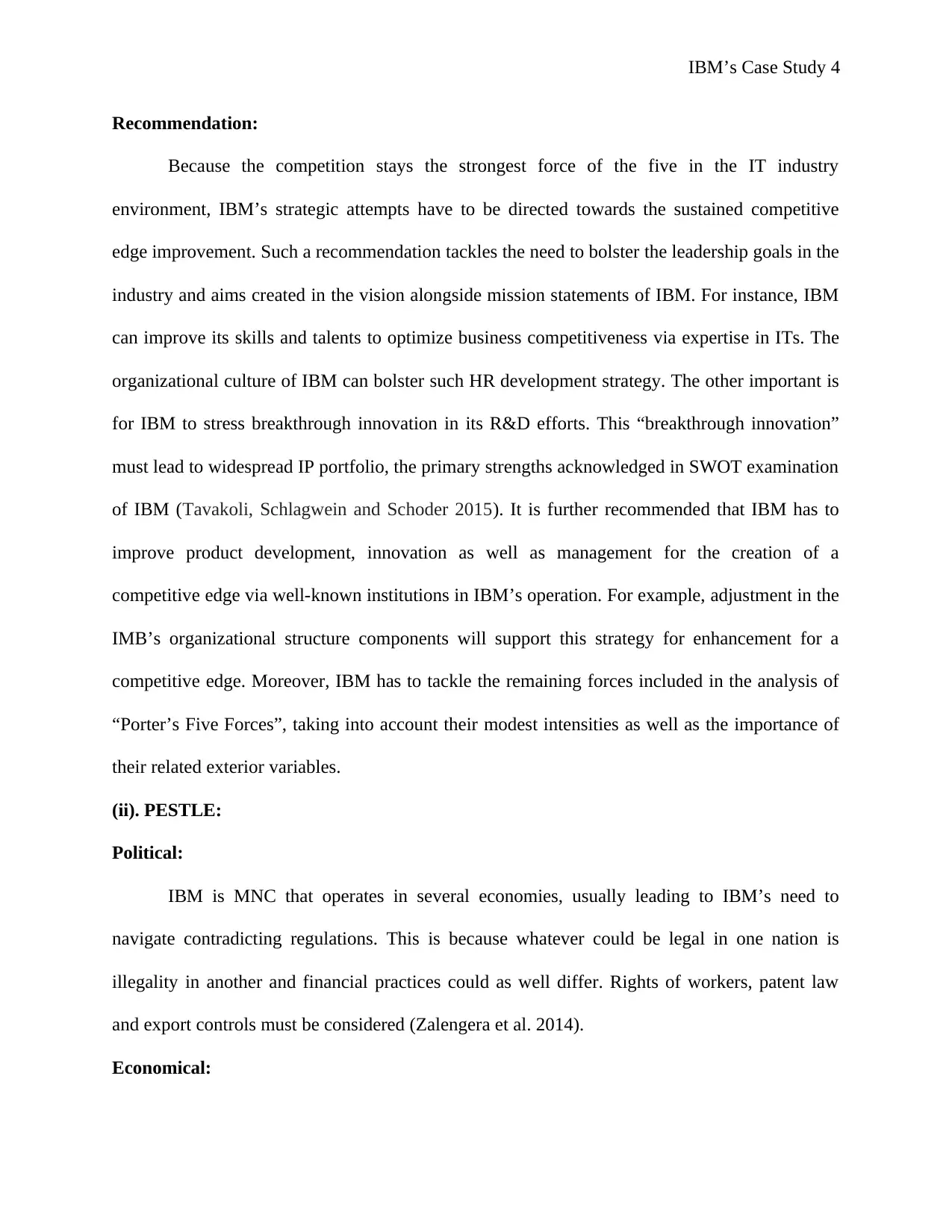
IBM’s Case Study 4
Recommendation:
Because the competition stays the strongest force of the five in the IT industry
environment, IBM’s strategic attempts have to be directed towards the sustained competitive
edge improvement. Such a recommendation tackles the need to bolster the leadership goals in the
industry and aims created in the vision alongside mission statements of IBM. For instance, IBM
can improve its skills and talents to optimize business competitiveness via expertise in ITs. The
organizational culture of IBM can bolster such HR development strategy. The other important is
for IBM to stress breakthrough innovation in its R&D efforts. This “breakthrough innovation”
must lead to widespread IP portfolio, the primary strengths acknowledged in SWOT examination
of IBM (Tavakoli, Schlagwein and Schoder 2015). It is further recommended that IBM has to
improve product development, innovation as well as management for the creation of a
competitive edge via well-known institutions in IBM’s operation. For example, adjustment in the
IMB’s organizational structure components will support this strategy for enhancement for a
competitive edge. Moreover, IBM has to tackle the remaining forces included in the analysis of
“Porter’s Five Forces”, taking into account their modest intensities as well as the importance of
their related exterior variables.
(ii). PESTLE:
Political:
IBM is MNC that operates in several economies, usually leading to IBM’s need to
navigate contradicting regulations. This is because whatever could be legal in one nation is
illegality in another and financial practices could as well differ. Rights of workers, patent law
and export controls must be considered (Zalengera et al. 2014).
Economical:
Recommendation:
Because the competition stays the strongest force of the five in the IT industry
environment, IBM’s strategic attempts have to be directed towards the sustained competitive
edge improvement. Such a recommendation tackles the need to bolster the leadership goals in the
industry and aims created in the vision alongside mission statements of IBM. For instance, IBM
can improve its skills and talents to optimize business competitiveness via expertise in ITs. The
organizational culture of IBM can bolster such HR development strategy. The other important is
for IBM to stress breakthrough innovation in its R&D efforts. This “breakthrough innovation”
must lead to widespread IP portfolio, the primary strengths acknowledged in SWOT examination
of IBM (Tavakoli, Schlagwein and Schoder 2015). It is further recommended that IBM has to
improve product development, innovation as well as management for the creation of a
competitive edge via well-known institutions in IBM’s operation. For example, adjustment in the
IMB’s organizational structure components will support this strategy for enhancement for a
competitive edge. Moreover, IBM has to tackle the remaining forces included in the analysis of
“Porter’s Five Forces”, taking into account their modest intensities as well as the importance of
their related exterior variables.
(ii). PESTLE:
Political:
IBM is MNC that operates in several economies, usually leading to IBM’s need to
navigate contradicting regulations. This is because whatever could be legal in one nation is
illegality in another and financial practices could as well differ. Rights of workers, patent law
and export controls must be considered (Zalengera et al. 2014).
Economical:
Secure Best Marks with AI Grader
Need help grading? Try our AI Grader for instant feedback on your assignments.
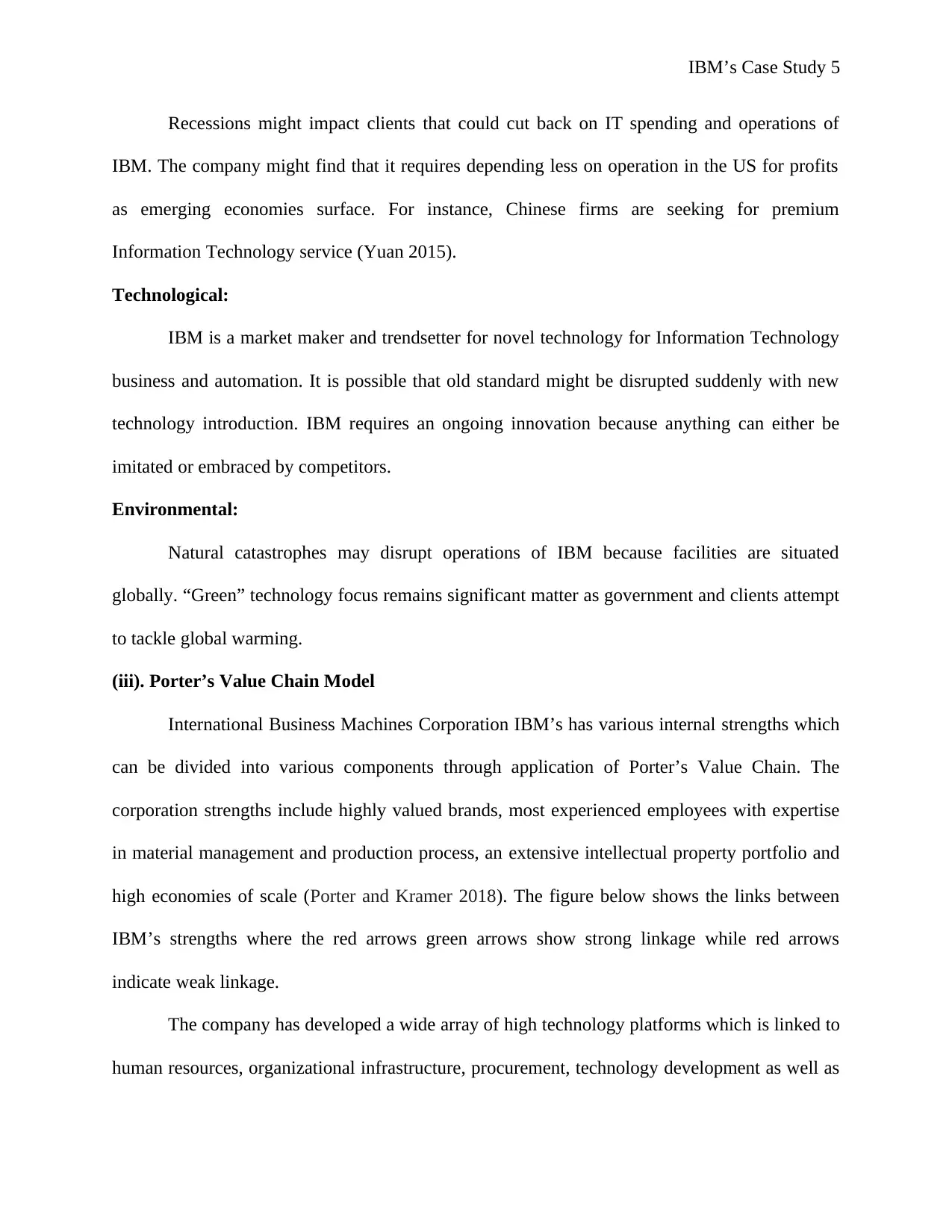
IBM’s Case Study 5
Recessions might impact clients that could cut back on IT spending and operations of
IBM. The company might find that it requires depending less on operation in the US for profits
as emerging economies surface. For instance, Chinese firms are seeking for premium
Information Technology service (Yuan 2015).
Technological:
IBM is a market maker and trendsetter for novel technology for Information Technology
business and automation. It is possible that old standard might be disrupted suddenly with new
technology introduction. IBM requires an ongoing innovation because anything can either be
imitated or embraced by competitors.
Environmental:
Natural catastrophes may disrupt operations of IBM because facilities are situated
globally. “Green” technology focus remains significant matter as government and clients attempt
to tackle global warming.
(iii). Porter’s Value Chain Model
International Business Machines Corporation IBM’s has various internal strengths which
can be divided into various components through application of Porter’s Value Chain. The
corporation strengths include highly valued brands, most experienced employees with expertise
in material management and production process, an extensive intellectual property portfolio and
high economies of scale (Porter and Kramer 2018). The figure below shows the links between
IBM’s strengths where the red arrows green arrows show strong linkage while red arrows
indicate weak linkage.
The company has developed a wide array of high technology platforms which is linked to
human resources, organizational infrastructure, procurement, technology development as well as
Recessions might impact clients that could cut back on IT spending and operations of
IBM. The company might find that it requires depending less on operation in the US for profits
as emerging economies surface. For instance, Chinese firms are seeking for premium
Information Technology service (Yuan 2015).
Technological:
IBM is a market maker and trendsetter for novel technology for Information Technology
business and automation. It is possible that old standard might be disrupted suddenly with new
technology introduction. IBM requires an ongoing innovation because anything can either be
imitated or embraced by competitors.
Environmental:
Natural catastrophes may disrupt operations of IBM because facilities are situated
globally. “Green” technology focus remains significant matter as government and clients attempt
to tackle global warming.
(iii). Porter’s Value Chain Model
International Business Machines Corporation IBM’s has various internal strengths which
can be divided into various components through application of Porter’s Value Chain. The
corporation strengths include highly valued brands, most experienced employees with expertise
in material management and production process, an extensive intellectual property portfolio and
high economies of scale (Porter and Kramer 2018). The figure below shows the links between
IBM’s strengths where the red arrows green arrows show strong linkage while red arrows
indicate weak linkage.
The company has developed a wide array of high technology platforms which is linked to
human resources, organizational infrastructure, procurement, technology development as well as
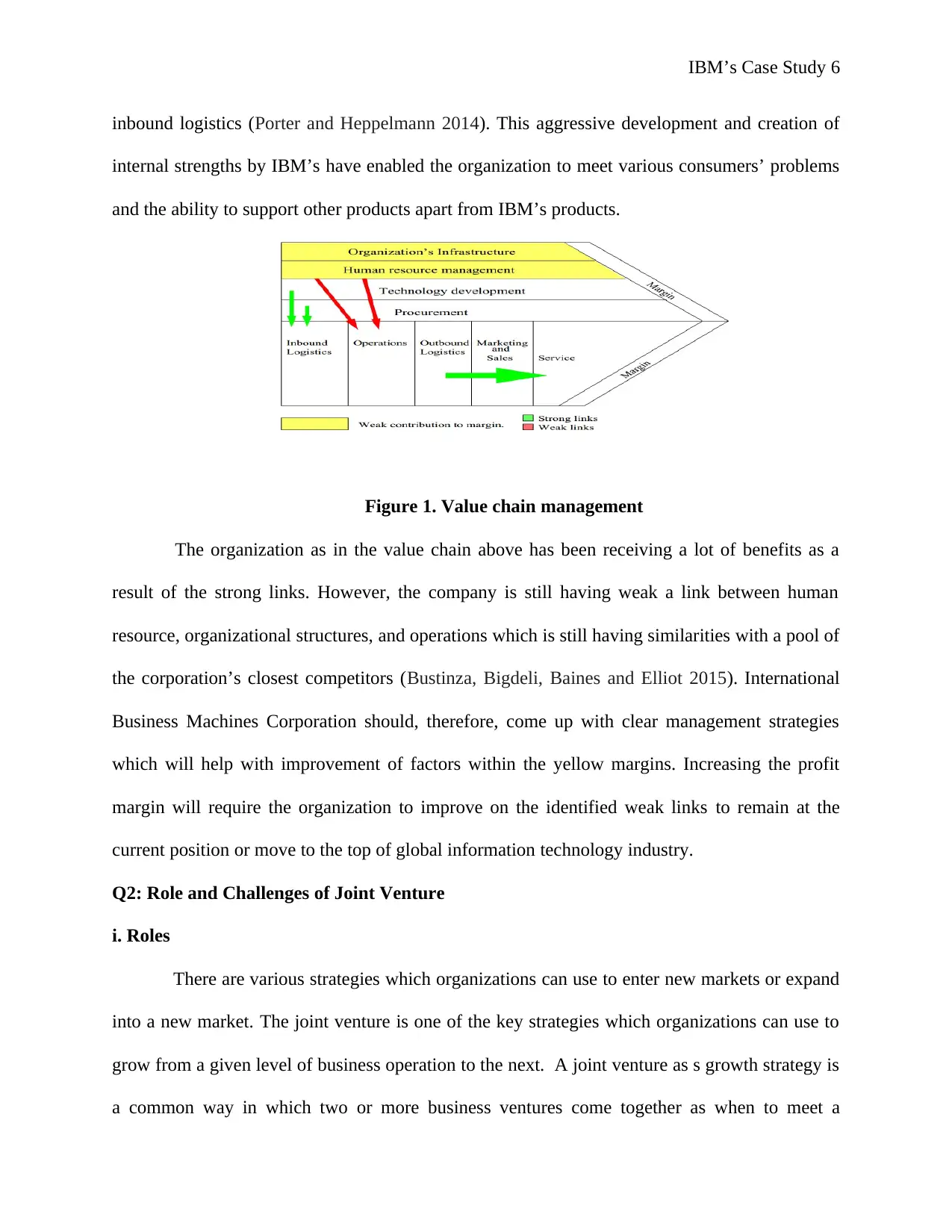
IBM’s Case Study 6
inbound logistics (Porter and Heppelmann 2014). This aggressive development and creation of
internal strengths by IBM’s have enabled the organization to meet various consumers’ problems
and the ability to support other products apart from IBM’s products.
Figure 1. Value chain management
The organization as in the value chain above has been receiving a lot of benefits as a
result of the strong links. However, the company is still having weak a link between human
resource, organizational structures, and operations which is still having similarities with a pool of
the corporation’s closest competitors (Bustinza, Bigdeli, Baines and Elliot 2015). International
Business Machines Corporation should, therefore, come up with clear management strategies
which will help with improvement of factors within the yellow margins. Increasing the profit
margin will require the organization to improve on the identified weak links to remain at the
current position or move to the top of global information technology industry.
Q2: Role and Challenges of Joint Venture
i. Roles
There are various strategies which organizations can use to enter new markets or expand
into a new market. The joint venture is one of the key strategies which organizations can use to
grow from a given level of business operation to the next. A joint venture as s growth strategy is
a common way in which two or more business ventures come together as when to meet a
inbound logistics (Porter and Heppelmann 2014). This aggressive development and creation of
internal strengths by IBM’s have enabled the organization to meet various consumers’ problems
and the ability to support other products apart from IBM’s products.
Figure 1. Value chain management
The organization as in the value chain above has been receiving a lot of benefits as a
result of the strong links. However, the company is still having weak a link between human
resource, organizational structures, and operations which is still having similarities with a pool of
the corporation’s closest competitors (Bustinza, Bigdeli, Baines and Elliot 2015). International
Business Machines Corporation should, therefore, come up with clear management strategies
which will help with improvement of factors within the yellow margins. Increasing the profit
margin will require the organization to improve on the identified weak links to remain at the
current position or move to the top of global information technology industry.
Q2: Role and Challenges of Joint Venture
i. Roles
There are various strategies which organizations can use to enter new markets or expand
into a new market. The joint venture is one of the key strategies which organizations can use to
grow from a given level of business operation to the next. A joint venture as s growth strategy is
a common way in which two or more business ventures come together as when to meet a
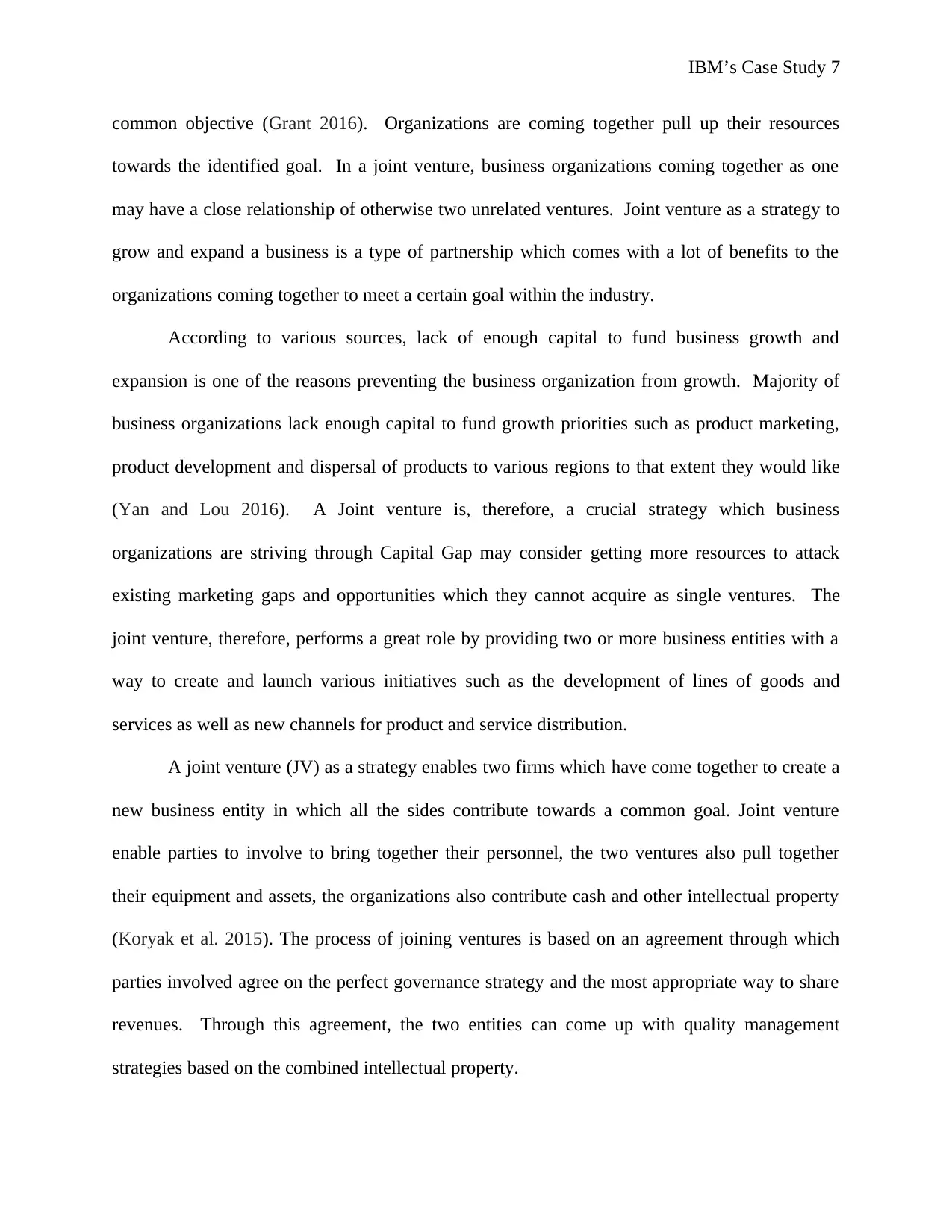
IBM’s Case Study 7
common objective (Grant 2016). Organizations are coming together pull up their resources
towards the identified goal. In a joint venture, business organizations coming together as one
may have a close relationship of otherwise two unrelated ventures. Joint venture as a strategy to
grow and expand a business is a type of partnership which comes with a lot of benefits to the
organizations coming together to meet a certain goal within the industry.
According to various sources, lack of enough capital to fund business growth and
expansion is one of the reasons preventing the business organization from growth. Majority of
business organizations lack enough capital to fund growth priorities such as product marketing,
product development and dispersal of products to various regions to that extent they would like
(Yan and Lou 2016). A Joint venture is, therefore, a crucial strategy which business
organizations are striving through Capital Gap may consider getting more resources to attack
existing marketing gaps and opportunities which they cannot acquire as single ventures. The
joint venture, therefore, performs a great role by providing two or more business entities with a
way to create and launch various initiatives such as the development of lines of goods and
services as well as new channels for product and service distribution.
A joint venture (JV) as a strategy enables two firms which have come together to create a
new business entity in which all the sides contribute towards a common goal. Joint venture
enable parties to involve to bring together their personnel, the two ventures also pull together
their equipment and assets, the organizations also contribute cash and other intellectual property
(Koryak et al. 2015). The process of joining ventures is based on an agreement through which
parties involved agree on the perfect governance strategy and the most appropriate way to share
revenues. Through this agreement, the two entities can come up with quality management
strategies based on the combined intellectual property.
common objective (Grant 2016). Organizations are coming together pull up their resources
towards the identified goal. In a joint venture, business organizations coming together as one
may have a close relationship of otherwise two unrelated ventures. Joint venture as a strategy to
grow and expand a business is a type of partnership which comes with a lot of benefits to the
organizations coming together to meet a certain goal within the industry.
According to various sources, lack of enough capital to fund business growth and
expansion is one of the reasons preventing the business organization from growth. Majority of
business organizations lack enough capital to fund growth priorities such as product marketing,
product development and dispersal of products to various regions to that extent they would like
(Yan and Lou 2016). A Joint venture is, therefore, a crucial strategy which business
organizations are striving through Capital Gap may consider getting more resources to attack
existing marketing gaps and opportunities which they cannot acquire as single ventures. The
joint venture, therefore, performs a great role by providing two or more business entities with a
way to create and launch various initiatives such as the development of lines of goods and
services as well as new channels for product and service distribution.
A joint venture (JV) as a strategy enables two firms which have come together to create a
new business entity in which all the sides contribute towards a common goal. Joint venture
enable parties to involve to bring together their personnel, the two ventures also pull together
their equipment and assets, the organizations also contribute cash and other intellectual property
(Koryak et al. 2015). The process of joining ventures is based on an agreement through which
parties involved agree on the perfect governance strategy and the most appropriate way to share
revenues. Through this agreement, the two entities can come up with quality management
strategies based on the combined intellectual property.
Paraphrase This Document
Need a fresh take? Get an instant paraphrase of this document with our AI Paraphraser
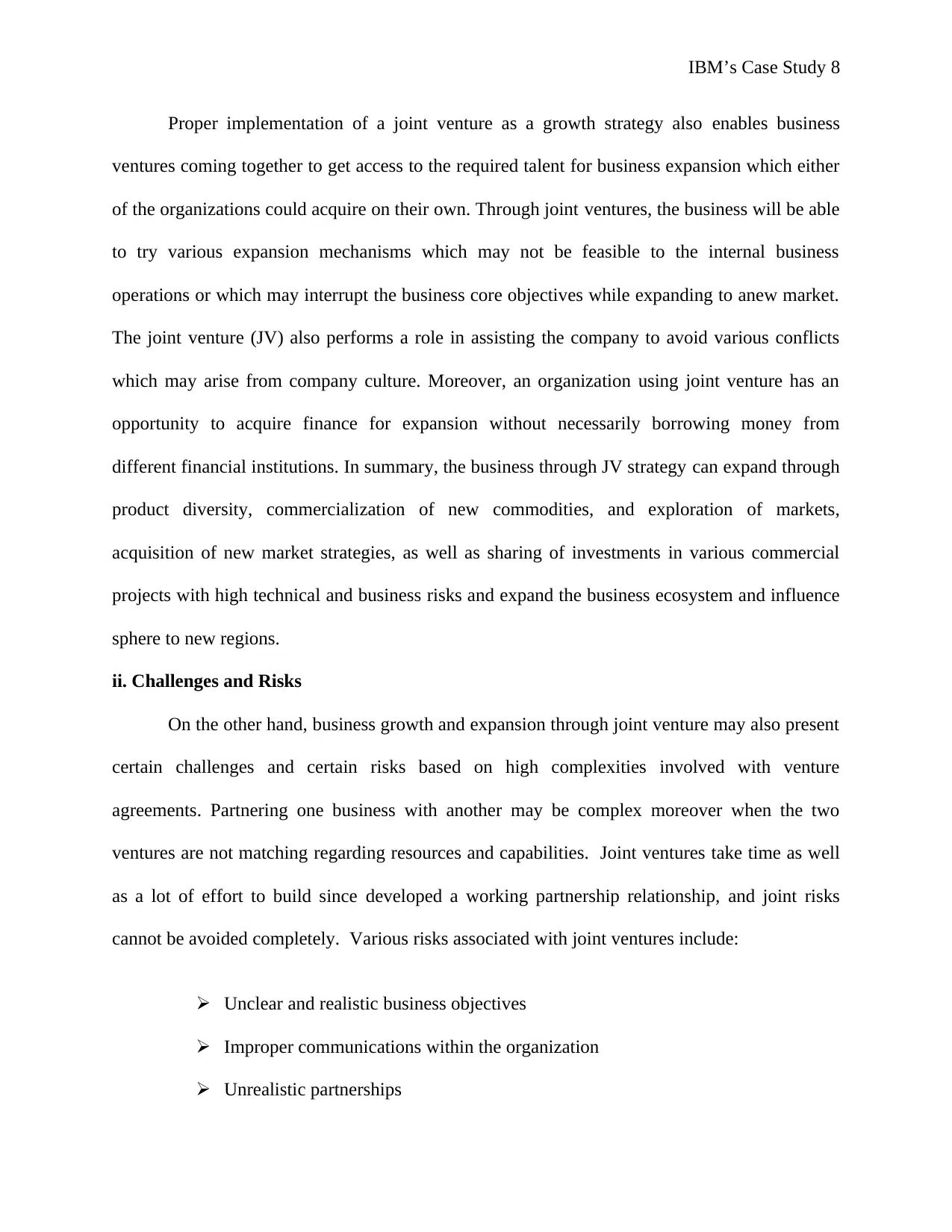
IBM’s Case Study 8
Proper implementation of a joint venture as a growth strategy also enables business
ventures coming together to get access to the required talent for business expansion which either
of the organizations could acquire on their own. Through joint ventures, the business will be able
to try various expansion mechanisms which may not be feasible to the internal business
operations or which may interrupt the business core objectives while expanding to anew market.
The joint venture (JV) also performs a role in assisting the company to avoid various conflicts
which may arise from company culture. Moreover, an organization using joint venture has an
opportunity to acquire finance for expansion without necessarily borrowing money from
different financial institutions. In summary, the business through JV strategy can expand through
product diversity, commercialization of new commodities, and exploration of markets,
acquisition of new market strategies, as well as sharing of investments in various commercial
projects with high technical and business risks and expand the business ecosystem and influence
sphere to new regions.
ii. Challenges and Risks
On the other hand, business growth and expansion through joint venture may also present
certain challenges and certain risks based on high complexities involved with venture
agreements. Partnering one business with another may be complex moreover when the two
ventures are not matching regarding resources and capabilities. Joint ventures take time as well
as a lot of effort to build since developed a working partnership relationship, and joint risks
cannot be avoided completely. Various risks associated with joint ventures include:
Unclear and realistic business objectives
Improper communications within the organization
Unrealistic partnerships
Proper implementation of a joint venture as a growth strategy also enables business
ventures coming together to get access to the required talent for business expansion which either
of the organizations could acquire on their own. Through joint ventures, the business will be able
to try various expansion mechanisms which may not be feasible to the internal business
operations or which may interrupt the business core objectives while expanding to anew market.
The joint venture (JV) also performs a role in assisting the company to avoid various conflicts
which may arise from company culture. Moreover, an organization using joint venture has an
opportunity to acquire finance for expansion without necessarily borrowing money from
different financial institutions. In summary, the business through JV strategy can expand through
product diversity, commercialization of new commodities, and exploration of markets,
acquisition of new market strategies, as well as sharing of investments in various commercial
projects with high technical and business risks and expand the business ecosystem and influence
sphere to new regions.
ii. Challenges and Risks
On the other hand, business growth and expansion through joint venture may also present
certain challenges and certain risks based on high complexities involved with venture
agreements. Partnering one business with another may be complex moreover when the two
ventures are not matching regarding resources and capabilities. Joint ventures take time as well
as a lot of effort to build since developed a working partnership relationship, and joint risks
cannot be avoided completely. Various risks associated with joint ventures include:
Unclear and realistic business objectives
Improper communications within the organization
Unrealistic partnerships
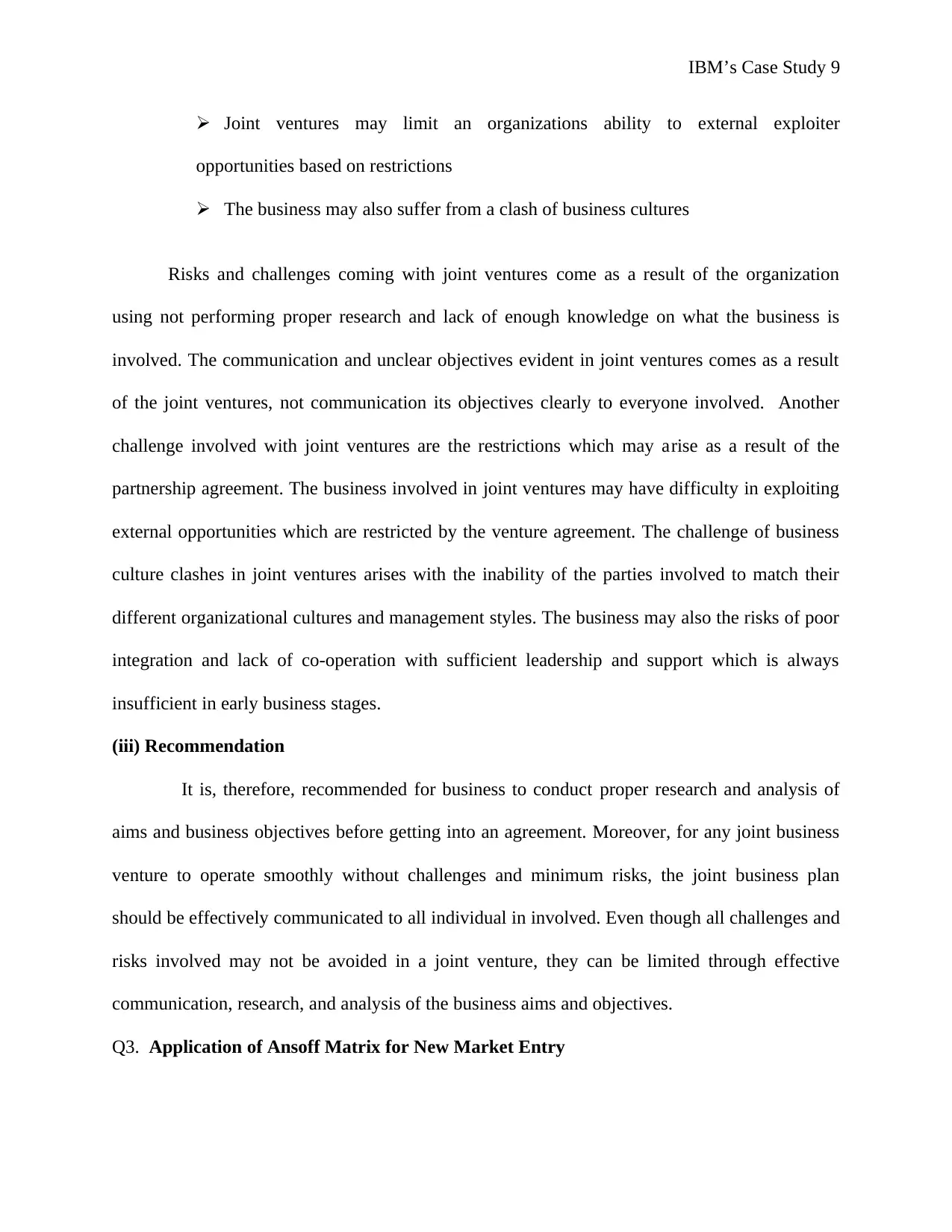
IBM’s Case Study 9
Joint ventures may limit an organizations ability to external exploiter
opportunities based on restrictions
The business may also suffer from a clash of business cultures
Risks and challenges coming with joint ventures come as a result of the organization
using not performing proper research and lack of enough knowledge on what the business is
involved. The communication and unclear objectives evident in joint ventures comes as a result
of the joint ventures, not communication its objectives clearly to everyone involved. Another
challenge involved with joint ventures are the restrictions which may arise as a result of the
partnership agreement. The business involved in joint ventures may have difficulty in exploiting
external opportunities which are restricted by the venture agreement. The challenge of business
culture clashes in joint ventures arises with the inability of the parties involved to match their
different organizational cultures and management styles. The business may also the risks of poor
integration and lack of co-operation with sufficient leadership and support which is always
insufficient in early business stages.
(iii) Recommendation
It is, therefore, recommended for business to conduct proper research and analysis of
aims and business objectives before getting into an agreement. Moreover, for any joint business
venture to operate smoothly without challenges and minimum risks, the joint business plan
should be effectively communicated to all individual in involved. Even though all challenges and
risks involved may not be avoided in a joint venture, they can be limited through effective
communication, research, and analysis of the business aims and objectives.
Q3. Application of Ansoff Matrix for New Market Entry
Joint ventures may limit an organizations ability to external exploiter
opportunities based on restrictions
The business may also suffer from a clash of business cultures
Risks and challenges coming with joint ventures come as a result of the organization
using not performing proper research and lack of enough knowledge on what the business is
involved. The communication and unclear objectives evident in joint ventures comes as a result
of the joint ventures, not communication its objectives clearly to everyone involved. Another
challenge involved with joint ventures are the restrictions which may arise as a result of the
partnership agreement. The business involved in joint ventures may have difficulty in exploiting
external opportunities which are restricted by the venture agreement. The challenge of business
culture clashes in joint ventures arises with the inability of the parties involved to match their
different organizational cultures and management styles. The business may also the risks of poor
integration and lack of co-operation with sufficient leadership and support which is always
insufficient in early business stages.
(iii) Recommendation
It is, therefore, recommended for business to conduct proper research and analysis of
aims and business objectives before getting into an agreement. Moreover, for any joint business
venture to operate smoothly without challenges and minimum risks, the joint business plan
should be effectively communicated to all individual in involved. Even though all challenges and
risks involved may not be avoided in a joint venture, they can be limited through effective
communication, research, and analysis of the business aims and objectives.
Q3. Application of Ansoff Matrix for New Market Entry
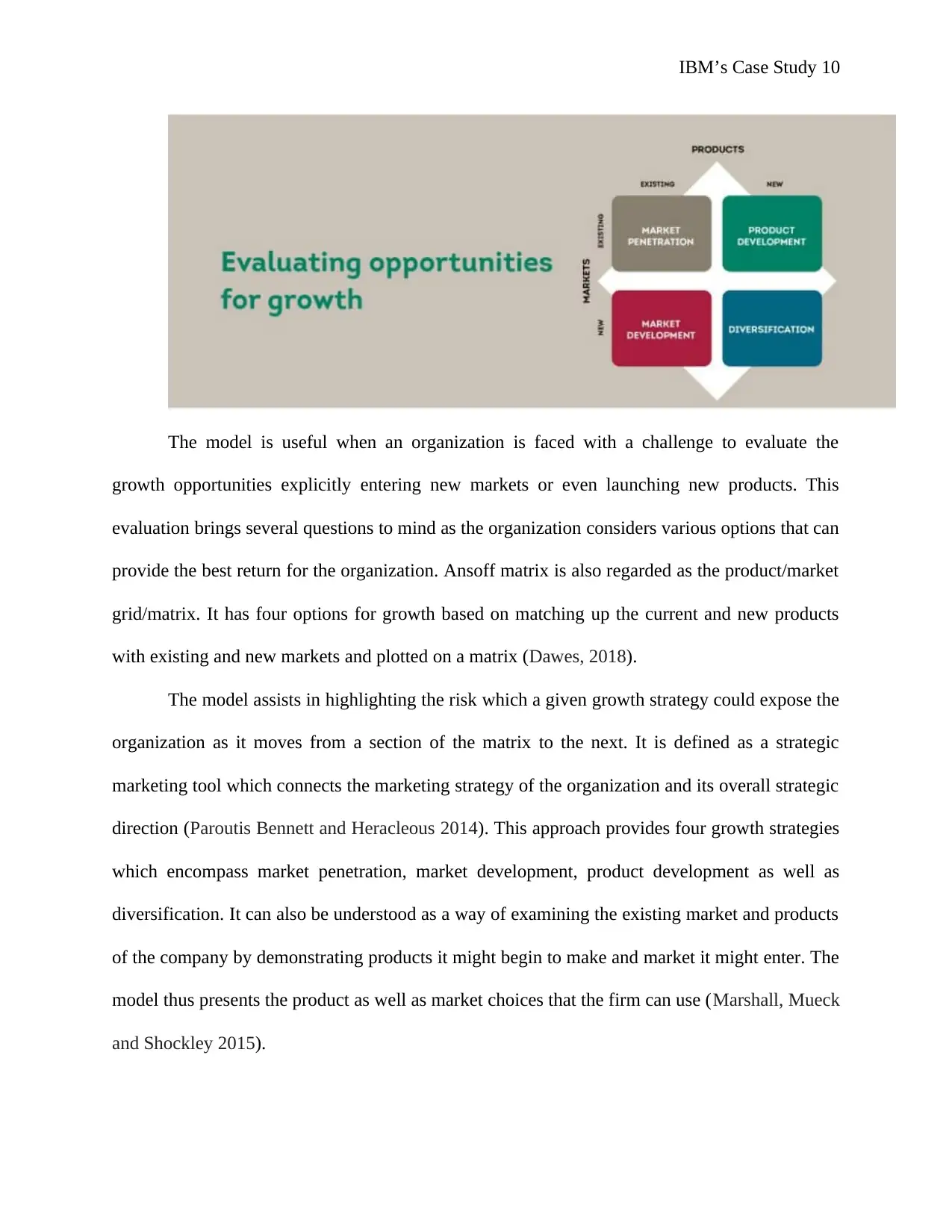
IBM’s Case Study 10
The model is useful when an organization is faced with a challenge to evaluate the
growth opportunities explicitly entering new markets or even launching new products. This
evaluation brings several questions to mind as the organization considers various options that can
provide the best return for the organization. Ansoff matrix is also regarded as the product/market
grid/matrix. It has four options for growth based on matching up the current and new products
with existing and new markets and plotted on a matrix (Dawes, 2018).
The model assists in highlighting the risk which a given growth strategy could expose the
organization as it moves from a section of the matrix to the next. It is defined as a strategic
marketing tool which connects the marketing strategy of the organization and its overall strategic
direction (Paroutis Bennett and Heracleous 2014). This approach provides four growth strategies
which encompass market penetration, market development, product development as well as
diversification. It can also be understood as a way of examining the existing market and products
of the company by demonstrating products it might begin to make and market it might enter. The
model thus presents the product as well as market choices that the firm can use (Marshall, Mueck
and Shockley 2015).
The model is useful when an organization is faced with a challenge to evaluate the
growth opportunities explicitly entering new markets or even launching new products. This
evaluation brings several questions to mind as the organization considers various options that can
provide the best return for the organization. Ansoff matrix is also regarded as the product/market
grid/matrix. It has four options for growth based on matching up the current and new products
with existing and new markets and plotted on a matrix (Dawes, 2018).
The model assists in highlighting the risk which a given growth strategy could expose the
organization as it moves from a section of the matrix to the next. It is defined as a strategic
marketing tool which connects the marketing strategy of the organization and its overall strategic
direction (Paroutis Bennett and Heracleous 2014). This approach provides four growth strategies
which encompass market penetration, market development, product development as well as
diversification. It can also be understood as a way of examining the existing market and products
of the company by demonstrating products it might begin to make and market it might enter. The
model thus presents the product as well as market choices that the firm can use (Marshall, Mueck
and Shockley 2015).
Secure Best Marks with AI Grader
Need help grading? Try our AI Grader for instant feedback on your assignments.
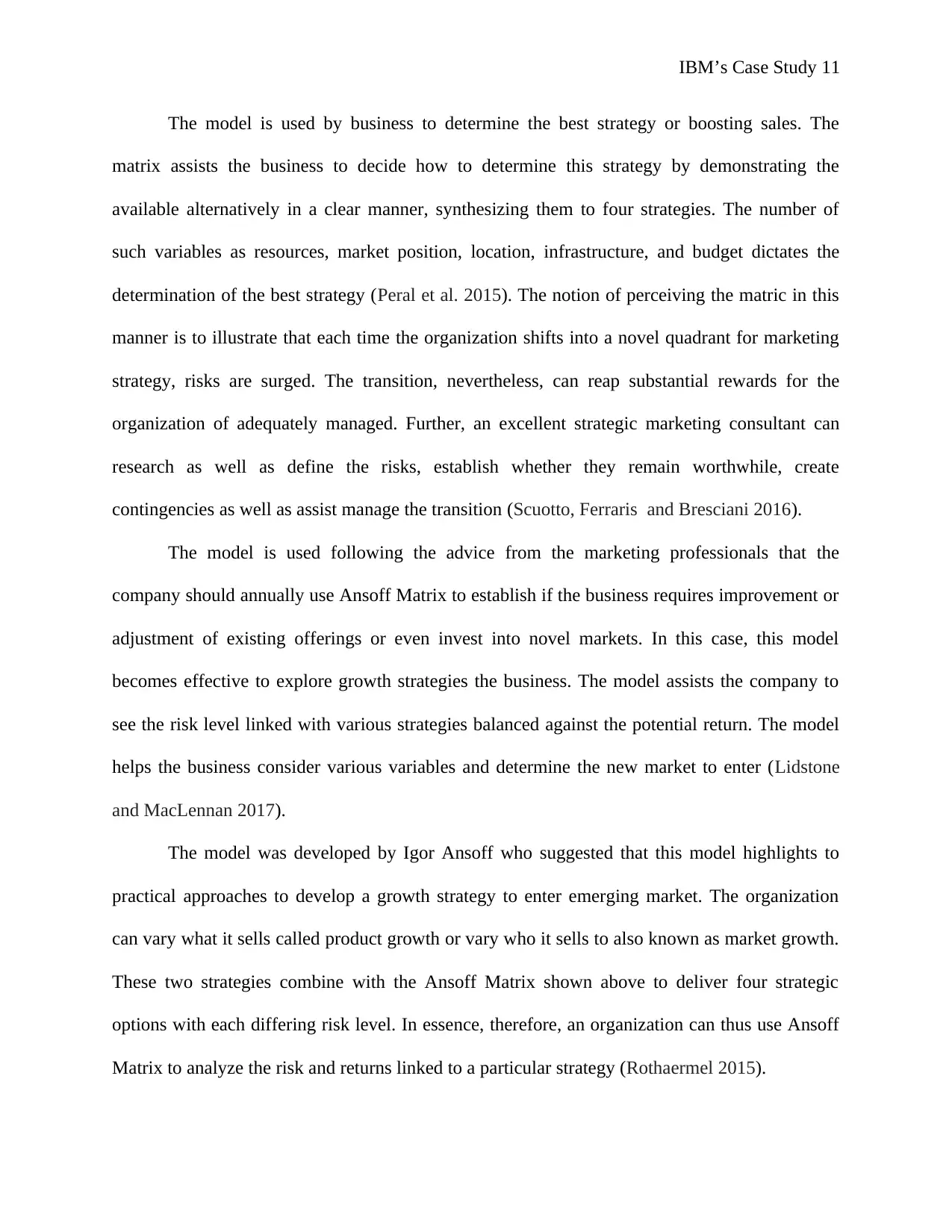
IBM’s Case Study 11
The model is used by business to determine the best strategy or boosting sales. The
matrix assists the business to decide how to determine this strategy by demonstrating the
available alternatively in a clear manner, synthesizing them to four strategies. The number of
such variables as resources, market position, location, infrastructure, and budget dictates the
determination of the best strategy (Peral et al. 2015). The notion of perceiving the matric in this
manner is to illustrate that each time the organization shifts into a novel quadrant for marketing
strategy, risks are surged. The transition, nevertheless, can reap substantial rewards for the
organization of adequately managed. Further, an excellent strategic marketing consultant can
research as well as define the risks, establish whether they remain worthwhile, create
contingencies as well as assist manage the transition (Scuotto, Ferraris and Bresciani 2016).
The model is used following the advice from the marketing professionals that the
company should annually use Ansoff Matrix to establish if the business requires improvement or
adjustment of existing offerings or even invest into novel markets. In this case, this model
becomes effective to explore growth strategies the business. The model assists the company to
see the risk level linked with various strategies balanced against the potential return. The model
helps the business consider various variables and determine the new market to enter (Lidstone
and MacLennan 2017).
The model was developed by Igor Ansoff who suggested that this model highlights to
practical approaches to develop a growth strategy to enter emerging market. The organization
can vary what it sells called product growth or vary who it sells to also known as market growth.
These two strategies combine with the Ansoff Matrix shown above to deliver four strategic
options with each differing risk level. In essence, therefore, an organization can thus use Ansoff
Matrix to analyze the risk and returns linked to a particular strategy (Rothaermel 2015).
The model is used by business to determine the best strategy or boosting sales. The
matrix assists the business to decide how to determine this strategy by demonstrating the
available alternatively in a clear manner, synthesizing them to four strategies. The number of
such variables as resources, market position, location, infrastructure, and budget dictates the
determination of the best strategy (Peral et al. 2015). The notion of perceiving the matric in this
manner is to illustrate that each time the organization shifts into a novel quadrant for marketing
strategy, risks are surged. The transition, nevertheless, can reap substantial rewards for the
organization of adequately managed. Further, an excellent strategic marketing consultant can
research as well as define the risks, establish whether they remain worthwhile, create
contingencies as well as assist manage the transition (Scuotto, Ferraris and Bresciani 2016).
The model is used following the advice from the marketing professionals that the
company should annually use Ansoff Matrix to establish if the business requires improvement or
adjustment of existing offerings or even invest into novel markets. In this case, this model
becomes effective to explore growth strategies the business. The model assists the company to
see the risk level linked with various strategies balanced against the potential return. The model
helps the business consider various variables and determine the new market to enter (Lidstone
and MacLennan 2017).
The model was developed by Igor Ansoff who suggested that this model highlights to
practical approaches to develop a growth strategy to enter emerging market. The organization
can vary what it sells called product growth or vary who it sells to also known as market growth.
These two strategies combine with the Ansoff Matrix shown above to deliver four strategic
options with each differing risk level. In essence, therefore, an organization can thus use Ansoff
Matrix to analyze the risk and returns linked to a particular strategy (Rothaermel 2015).
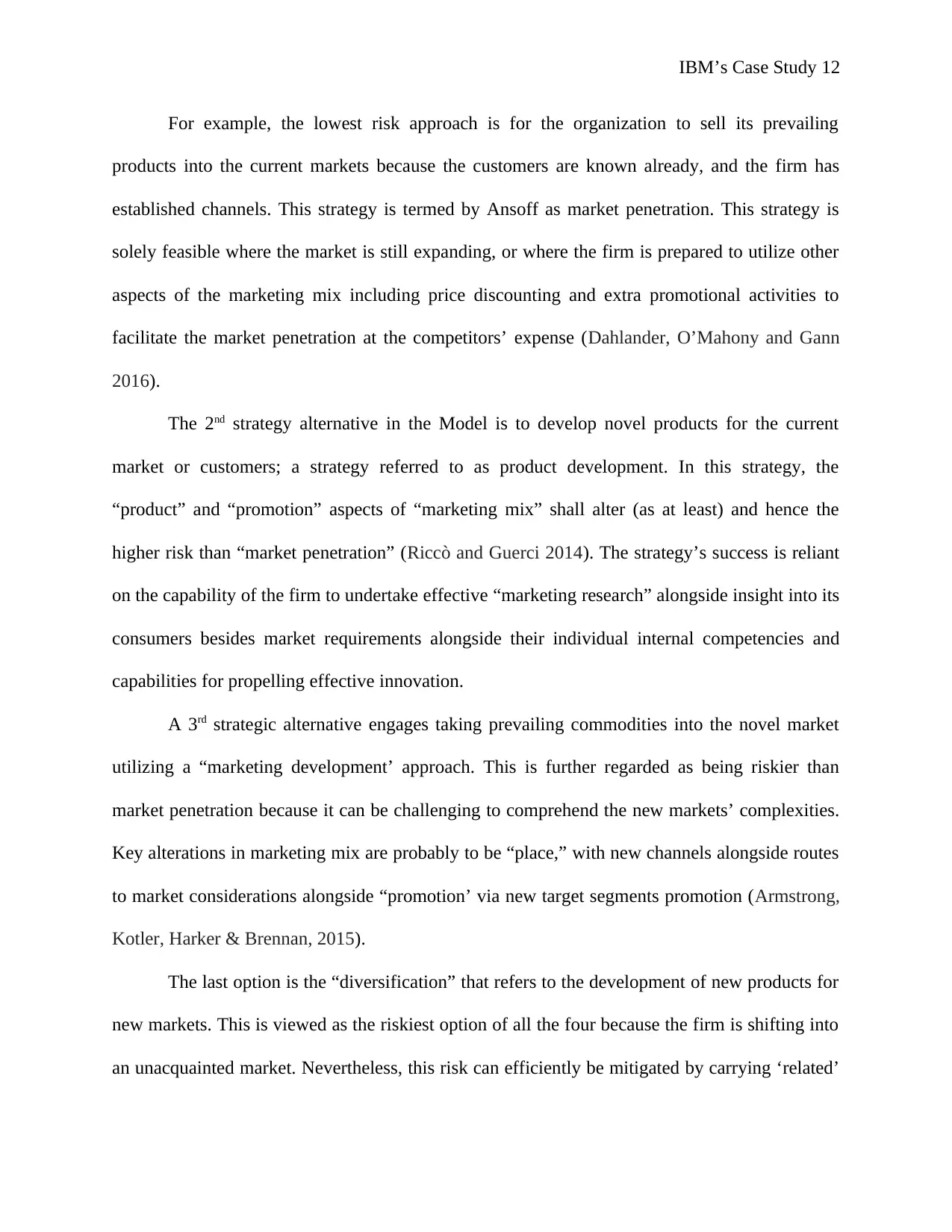
IBM’s Case Study 12
For example, the lowest risk approach is for the organization to sell its prevailing
products into the current markets because the customers are known already, and the firm has
established channels. This strategy is termed by Ansoff as market penetration. This strategy is
solely feasible where the market is still expanding, or where the firm is prepared to utilize other
aspects of the marketing mix including price discounting and extra promotional activities to
facilitate the market penetration at the competitors’ expense (Dahlander, O’Mahony and Gann
2016).
The 2nd strategy alternative in the Model is to develop novel products for the current
market or customers; a strategy referred to as product development. In this strategy, the
“product” and “promotion” aspects of “marketing mix” shall alter (as at least) and hence the
higher risk than “market penetration” (Riccò and Guerci 2014). The strategy’s success is reliant
on the capability of the firm to undertake effective “marketing research” alongside insight into its
consumers besides market requirements alongside their individual internal competencies and
capabilities for propelling effective innovation.
A 3rd strategic alternative engages taking prevailing commodities into the novel market
utilizing a “marketing development’ approach. This is further regarded as being riskier than
market penetration because it can be challenging to comprehend the new markets’ complexities.
Key alterations in marketing mix are probably to be “place,” with new channels alongside routes
to market considerations alongside “promotion’ via new target segments promotion (Armstrong,
Kotler, Harker & Brennan, 2015).
The last option is the “diversification” that refers to the development of new products for
new markets. This is viewed as the riskiest option of all the four because the firm is shifting into
an unacquainted market. Nevertheless, this risk can efficiently be mitigated by carrying ‘related’
For example, the lowest risk approach is for the organization to sell its prevailing
products into the current markets because the customers are known already, and the firm has
established channels. This strategy is termed by Ansoff as market penetration. This strategy is
solely feasible where the market is still expanding, or where the firm is prepared to utilize other
aspects of the marketing mix including price discounting and extra promotional activities to
facilitate the market penetration at the competitors’ expense (Dahlander, O’Mahony and Gann
2016).
The 2nd strategy alternative in the Model is to develop novel products for the current
market or customers; a strategy referred to as product development. In this strategy, the
“product” and “promotion” aspects of “marketing mix” shall alter (as at least) and hence the
higher risk than “market penetration” (Riccò and Guerci 2014). The strategy’s success is reliant
on the capability of the firm to undertake effective “marketing research” alongside insight into its
consumers besides market requirements alongside their individual internal competencies and
capabilities for propelling effective innovation.
A 3rd strategic alternative engages taking prevailing commodities into the novel market
utilizing a “marketing development’ approach. This is further regarded as being riskier than
market penetration because it can be challenging to comprehend the new markets’ complexities.
Key alterations in marketing mix are probably to be “place,” with new channels alongside routes
to market considerations alongside “promotion’ via new target segments promotion (Armstrong,
Kotler, Harker & Brennan, 2015).
The last option is the “diversification” that refers to the development of new products for
new markets. This is viewed as the riskiest option of all the four because the firm is shifting into
an unacquainted market. Nevertheless, this risk can efficiently be mitigated by carrying ‘related’
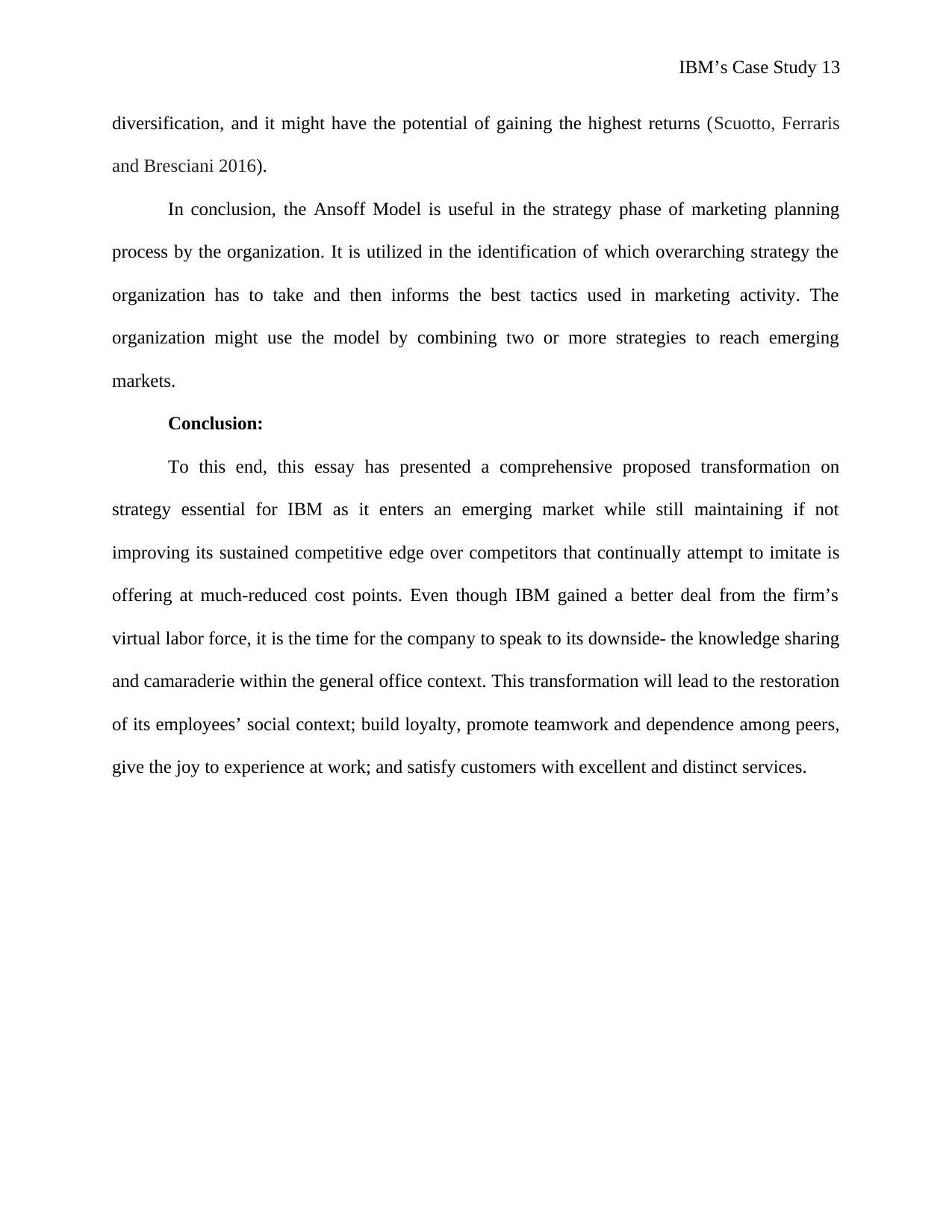
IBM’s Case Study 13
diversification, and it might have the potential of gaining the highest returns (Scuotto, Ferraris
and Bresciani 2016).
In conclusion, the Ansoff Model is useful in the strategy phase of marketing planning
process by the organization. It is utilized in the identification of which overarching strategy the
organization has to take and then informs the best tactics used in marketing activity. The
organization might use the model by combining two or more strategies to reach emerging
markets.
Conclusion:
To this end, this essay has presented a comprehensive proposed transformation on
strategy essential for IBM as it enters an emerging market while still maintaining if not
improving its sustained competitive edge over competitors that continually attempt to imitate is
offering at much-reduced cost points. Even though IBM gained a better deal from the firm’s
virtual labor force, it is the time for the company to speak to its downside- the knowledge sharing
and camaraderie within the general office context. This transformation will lead to the restoration
of its employees’ social context; build loyalty, promote teamwork and dependence among peers,
give the joy to experience at work; and satisfy customers with excellent and distinct services.
diversification, and it might have the potential of gaining the highest returns (Scuotto, Ferraris
and Bresciani 2016).
In conclusion, the Ansoff Model is useful in the strategy phase of marketing planning
process by the organization. It is utilized in the identification of which overarching strategy the
organization has to take and then informs the best tactics used in marketing activity. The
organization might use the model by combining two or more strategies to reach emerging
markets.
Conclusion:
To this end, this essay has presented a comprehensive proposed transformation on
strategy essential for IBM as it enters an emerging market while still maintaining if not
improving its sustained competitive edge over competitors that continually attempt to imitate is
offering at much-reduced cost points. Even though IBM gained a better deal from the firm’s
virtual labor force, it is the time for the company to speak to its downside- the knowledge sharing
and camaraderie within the general office context. This transformation will lead to the restoration
of its employees’ social context; build loyalty, promote teamwork and dependence among peers,
give the joy to experience at work; and satisfy customers with excellent and distinct services.
Paraphrase This Document
Need a fresh take? Get an instant paraphrase of this document with our AI Paraphraser
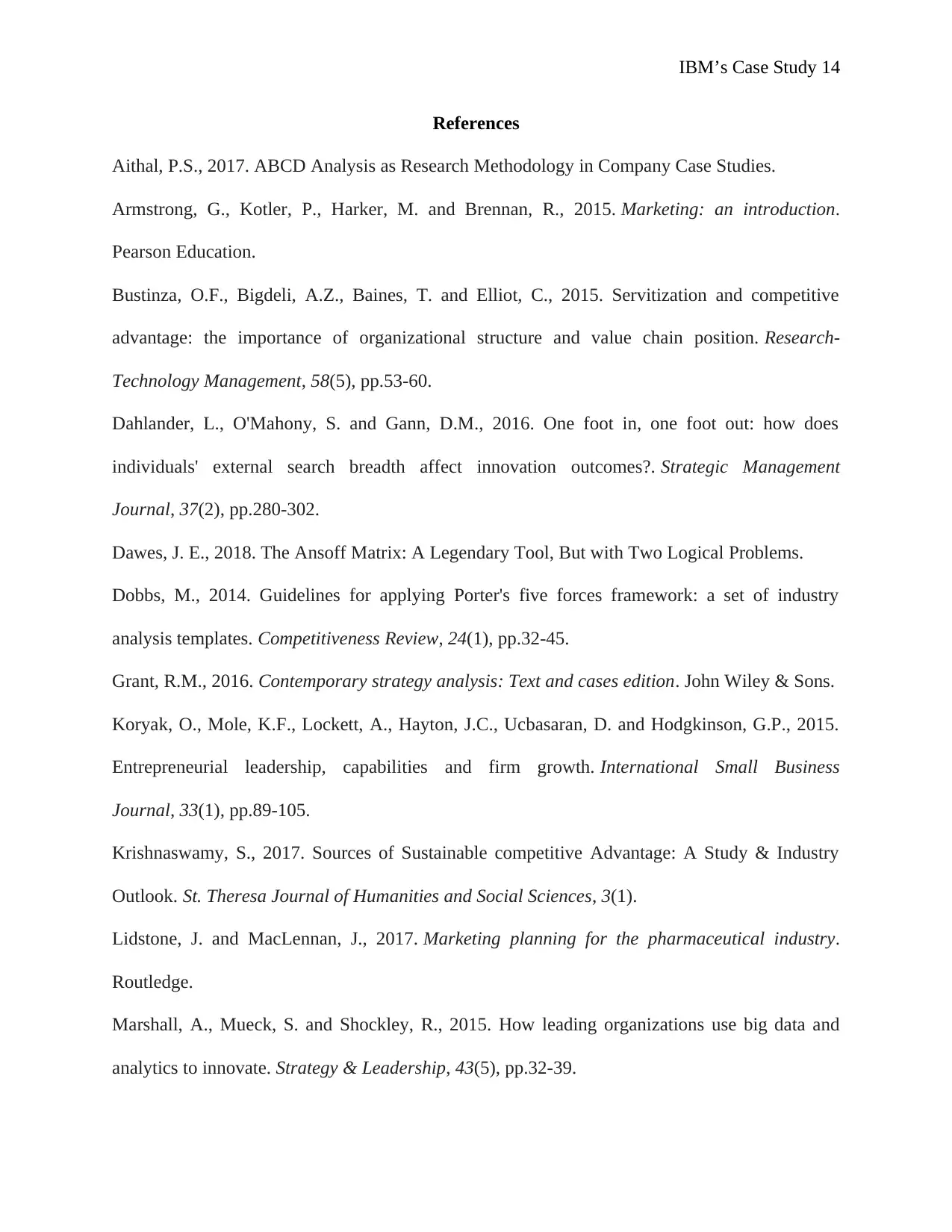
IBM’s Case Study 14
References
Aithal, P.S., 2017. ABCD Analysis as Research Methodology in Company Case Studies.
Armstrong, G., Kotler, P., Harker, M. and Brennan, R., 2015. Marketing: an introduction.
Pearson Education.
Bustinza, O.F., Bigdeli, A.Z., Baines, T. and Elliot, C., 2015. Servitization and competitive
advantage: the importance of organizational structure and value chain position. Research-
Technology Management, 58(5), pp.53-60.
Dahlander, L., O'Mahony, S. and Gann, D.M., 2016. One foot in, one foot out: how does
individuals' external search breadth affect innovation outcomes?. Strategic Management
Journal, 37(2), pp.280-302.
Dawes, J. E., 2018. The Ansoff Matrix: A Legendary Tool, But with Two Logical Problems.
Dobbs, M., 2014. Guidelines for applying Porter's five forces framework: a set of industry
analysis templates. Competitiveness Review, 24(1), pp.32-45.
Grant, R.M., 2016. Contemporary strategy analysis: Text and cases edition. John Wiley & Sons.
Koryak, O., Mole, K.F., Lockett, A., Hayton, J.C., Ucbasaran, D. and Hodgkinson, G.P., 2015.
Entrepreneurial leadership, capabilities and firm growth. International Small Business
Journal, 33(1), pp.89-105.
Krishnaswamy, S., 2017. Sources of Sustainable competitive Advantage: A Study & Industry
Outlook. St. Theresa Journal of Humanities and Social Sciences, 3(1).
Lidstone, J. and MacLennan, J., 2017. Marketing planning for the pharmaceutical industry.
Routledge.
Marshall, A., Mueck, S. and Shockley, R., 2015. How leading organizations use big data and
analytics to innovate. Strategy & Leadership, 43(5), pp.32-39.
References
Aithal, P.S., 2017. ABCD Analysis as Research Methodology in Company Case Studies.
Armstrong, G., Kotler, P., Harker, M. and Brennan, R., 2015. Marketing: an introduction.
Pearson Education.
Bustinza, O.F., Bigdeli, A.Z., Baines, T. and Elliot, C., 2015. Servitization and competitive
advantage: the importance of organizational structure and value chain position. Research-
Technology Management, 58(5), pp.53-60.
Dahlander, L., O'Mahony, S. and Gann, D.M., 2016. One foot in, one foot out: how does
individuals' external search breadth affect innovation outcomes?. Strategic Management
Journal, 37(2), pp.280-302.
Dawes, J. E., 2018. The Ansoff Matrix: A Legendary Tool, But with Two Logical Problems.
Dobbs, M., 2014. Guidelines for applying Porter's five forces framework: a set of industry
analysis templates. Competitiveness Review, 24(1), pp.32-45.
Grant, R.M., 2016. Contemporary strategy analysis: Text and cases edition. John Wiley & Sons.
Koryak, O., Mole, K.F., Lockett, A., Hayton, J.C., Ucbasaran, D. and Hodgkinson, G.P., 2015.
Entrepreneurial leadership, capabilities and firm growth. International Small Business
Journal, 33(1), pp.89-105.
Krishnaswamy, S., 2017. Sources of Sustainable competitive Advantage: A Study & Industry
Outlook. St. Theresa Journal of Humanities and Social Sciences, 3(1).
Lidstone, J. and MacLennan, J., 2017. Marketing planning for the pharmaceutical industry.
Routledge.
Marshall, A., Mueck, S. and Shockley, R., 2015. How leading organizations use big data and
analytics to innovate. Strategy & Leadership, 43(5), pp.32-39.
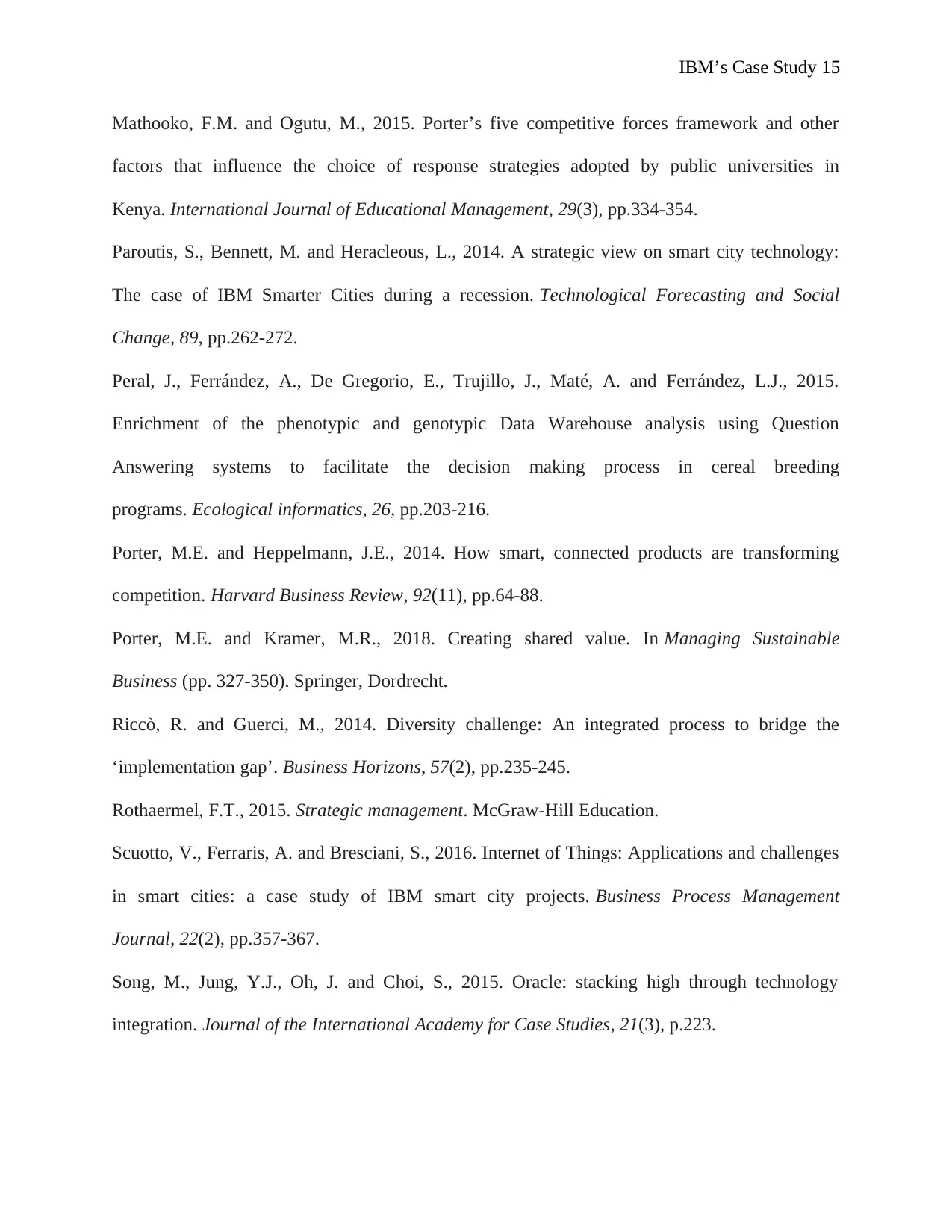
IBM’s Case Study 15
Mathooko, F.M. and Ogutu, M., 2015. Porter’s five competitive forces framework and other
factors that influence the choice of response strategies adopted by public universities in
Kenya. International Journal of Educational Management, 29(3), pp.334-354.
Paroutis, S., Bennett, M. and Heracleous, L., 2014. A strategic view on smart city technology:
The case of IBM Smarter Cities during a recession. Technological Forecasting and Social
Change, 89, pp.262-272.
Peral, J., Ferrández, A., De Gregorio, E., Trujillo, J., Maté, A. and Ferrández, L.J., 2015.
Enrichment of the phenotypic and genotypic Data Warehouse analysis using Question
Answering systems to facilitate the decision making process in cereal breeding
programs. Ecological informatics, 26, pp.203-216.
Porter, M.E. and Heppelmann, J.E., 2014. How smart, connected products are transforming
competition. Harvard Business Review, 92(11), pp.64-88.
Porter, M.E. and Kramer, M.R., 2018. Creating shared value. In Managing Sustainable
Business (pp. 327-350). Springer, Dordrecht.
Riccò, R. and Guerci, M., 2014. Diversity challenge: An integrated process to bridge the
‘implementation gap’. Business Horizons, 57(2), pp.235-245.
Rothaermel, F.T., 2015. Strategic management. McGraw-Hill Education.
Scuotto, V., Ferraris, A. and Bresciani, S., 2016. Internet of Things: Applications and challenges
in smart cities: a case study of IBM smart city projects. Business Process Management
Journal, 22(2), pp.357-367.
Song, M., Jung, Y.J., Oh, J. and Choi, S., 2015. Oracle: stacking high through technology
integration. Journal of the International Academy for Case Studies, 21(3), p.223.
Mathooko, F.M. and Ogutu, M., 2015. Porter’s five competitive forces framework and other
factors that influence the choice of response strategies adopted by public universities in
Kenya. International Journal of Educational Management, 29(3), pp.334-354.
Paroutis, S., Bennett, M. and Heracleous, L., 2014. A strategic view on smart city technology:
The case of IBM Smarter Cities during a recession. Technological Forecasting and Social
Change, 89, pp.262-272.
Peral, J., Ferrández, A., De Gregorio, E., Trujillo, J., Maté, A. and Ferrández, L.J., 2015.
Enrichment of the phenotypic and genotypic Data Warehouse analysis using Question
Answering systems to facilitate the decision making process in cereal breeding
programs. Ecological informatics, 26, pp.203-216.
Porter, M.E. and Heppelmann, J.E., 2014. How smart, connected products are transforming
competition. Harvard Business Review, 92(11), pp.64-88.
Porter, M.E. and Kramer, M.R., 2018. Creating shared value. In Managing Sustainable
Business (pp. 327-350). Springer, Dordrecht.
Riccò, R. and Guerci, M., 2014. Diversity challenge: An integrated process to bridge the
‘implementation gap’. Business Horizons, 57(2), pp.235-245.
Rothaermel, F.T., 2015. Strategic management. McGraw-Hill Education.
Scuotto, V., Ferraris, A. and Bresciani, S., 2016. Internet of Things: Applications and challenges
in smart cities: a case study of IBM smart city projects. Business Process Management
Journal, 22(2), pp.357-367.
Song, M., Jung, Y.J., Oh, J. and Choi, S., 2015. Oracle: stacking high through technology
integration. Journal of the International Academy for Case Studies, 21(3), p.223.
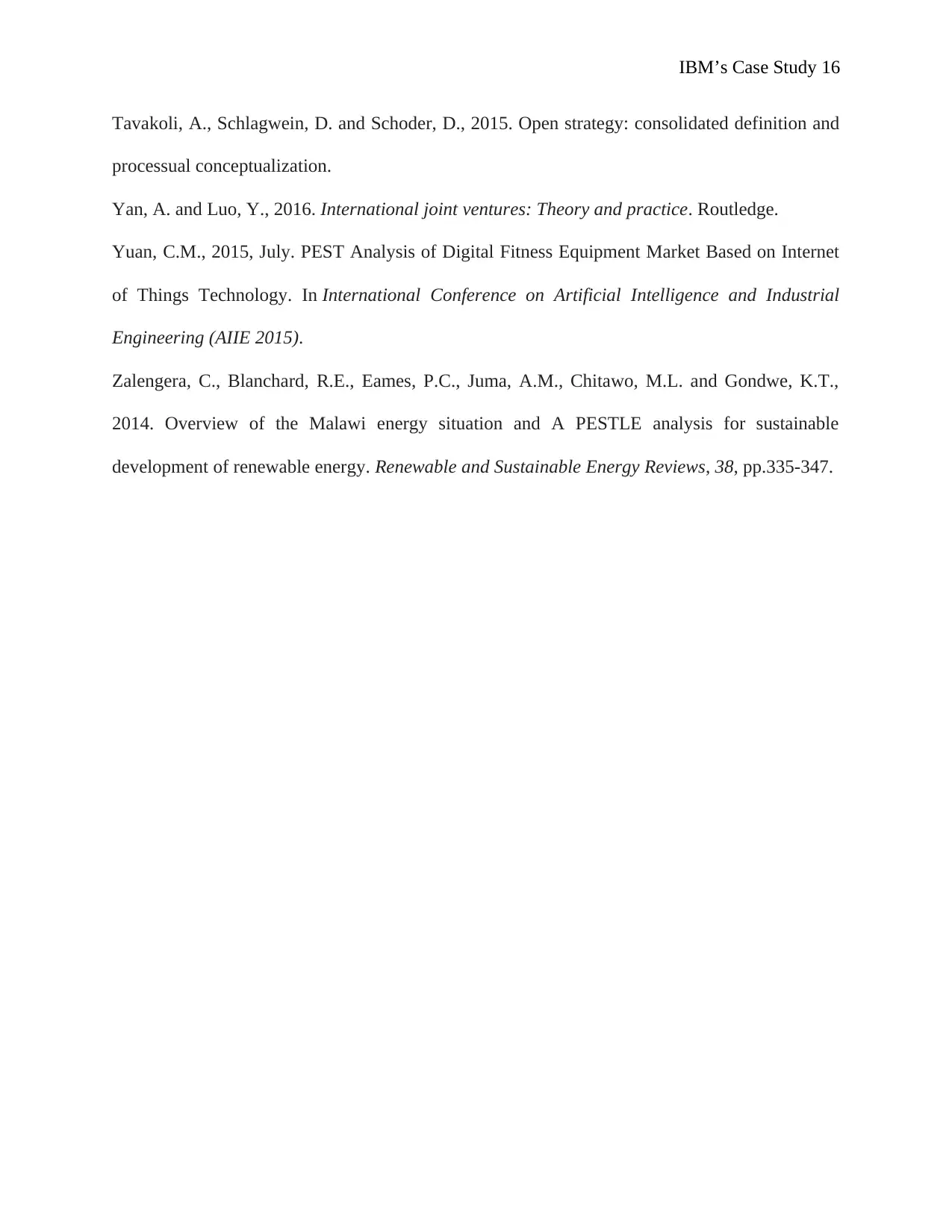
IBM’s Case Study 16
Tavakoli, A., Schlagwein, D. and Schoder, D., 2015. Open strategy: consolidated definition and
processual conceptualization.
Yan, A. and Luo, Y., 2016. International joint ventures: Theory and practice. Routledge.
Yuan, C.M., 2015, July. PEST Analysis of Digital Fitness Equipment Market Based on Internet
of Things Technology. In International Conference on Artificial Intelligence and Industrial
Engineering (AIIE 2015).
Zalengera, C., Blanchard, R.E., Eames, P.C., Juma, A.M., Chitawo, M.L. and Gondwe, K.T.,
2014. Overview of the Malawi energy situation and A PESTLE analysis for sustainable
development of renewable energy. Renewable and Sustainable Energy Reviews, 38, pp.335-347.
Tavakoli, A., Schlagwein, D. and Schoder, D., 2015. Open strategy: consolidated definition and
processual conceptualization.
Yan, A. and Luo, Y., 2016. International joint ventures: Theory and practice. Routledge.
Yuan, C.M., 2015, July. PEST Analysis of Digital Fitness Equipment Market Based on Internet
of Things Technology. In International Conference on Artificial Intelligence and Industrial
Engineering (AIIE 2015).
Zalengera, C., Blanchard, R.E., Eames, P.C., Juma, A.M., Chitawo, M.L. and Gondwe, K.T.,
2014. Overview of the Malawi energy situation and A PESTLE analysis for sustainable
development of renewable energy. Renewable and Sustainable Energy Reviews, 38, pp.335-347.
1 out of 16
Related Documents
Your All-in-One AI-Powered Toolkit for Academic Success.
+13062052269
info@desklib.com
Available 24*7 on WhatsApp / Email
![[object Object]](/_next/static/media/star-bottom.7253800d.svg)
Unlock your academic potential
© 2024 | Zucol Services PVT LTD | All rights reserved.





